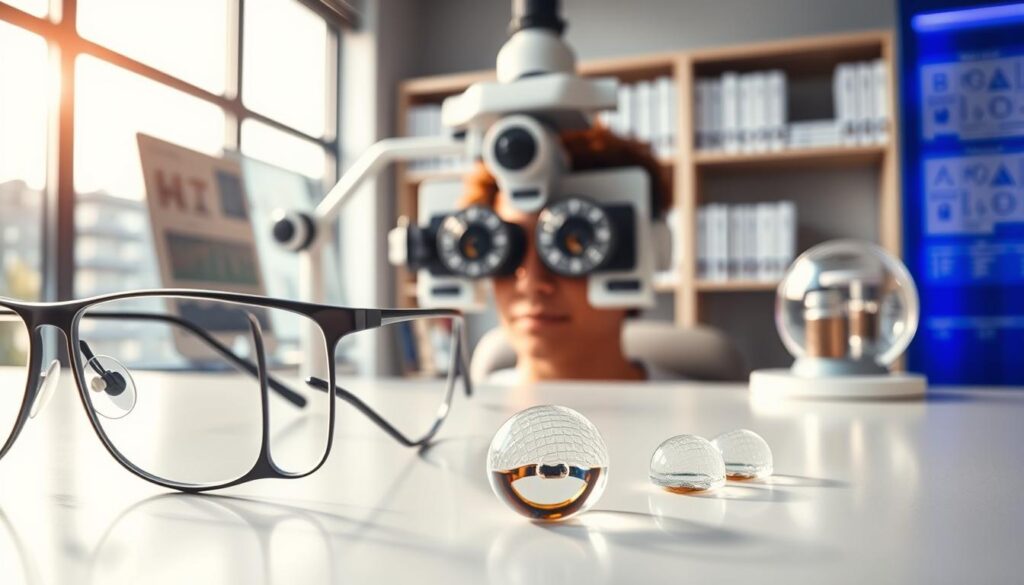Did you know nearly 3 million Americans have glaucoma, but many don’t know they have it1? Your eye health is much more complex and important than you might think. Vision care is not just about seeing clearly—it’s a key to your overall health1.
Eye health is a key part of your wellness that’s often ignored. You might think having perfect vision means your eyes are healthy, but there can be hidden dangers. Regular eye exams are crucial in catching problems early1.
Understanding eyesight means seeing our eyes as complex systems that need constant care. They help detect early signs of diseases and prevent vision loss. Getting comprehensive eye exams is key to keeping your health in check2.
Key Takeaways
- Eye health extends beyond visual clarity
- Regular eye exams can detect hidden health issues
- Glaucoma and other conditions can develop silently
- Proactive vision care is essential for long-term wellness
- Everyone should prioritize comprehensive eye check-ups
Understanding the Fundamentals of Vision Health
Your eyes are complex and fascinating organs that play a crucial role in how you interact with the world around you. Understanding eye anatomy and the vision process can help you appreciate the incredible mechanisms behind your ability to see.
The human eye is a remarkable structure designed to capture and process visual information with incredible precision. Your eye anatomy consists of several key components that work together to create clear vision.
Basic Components of Eye Anatomy
- Cornea: The clear front layer that helps focus light
- Iris: The colored part that controls light entering the eye
- Lens: Focuses light onto the retina
- Retina: Contains photoreceptors that convert light into electrical signals
- Optic nerve: Transmits visual information to the brain
Understanding the Vision Process
The vision process begins when light enters your eye through the cornea and pupil. Your lens then focuses this light onto the retina, where specialized cells called photoreceptors convert light into electrical signals. These signals travel through the optic nerve to your brain, which interprets them as images3.
Common Vision Terms Explained
| Vision Term | Definition |
|---|---|
| Visual Acuity | Sharpness or clarity of vision, typically measured using the 20/20 standard3 |
| Myopia | Nearsightedness – difficulty seeing distant objects4 |
| Hyperopia | Farsightedness – trouble focusing on nearby objects3 |
| Astigmatism | Blurred vision caused by an irregularly shaped cornea or lens3 |
Understanding these fundamental aspects of eye health empowers you to take better care of your vision. Regular eye exams and awareness of your eye anatomy can help you maintain optimal visual health4.
The Importance of Regular Eye Examinations
Your vision is a precious gift that needs constant care. Regular eye exams are key to preventive eye care. They do more than just check your vision5. They can find hidden health issues early.
Experts suggest different eye exam schedules based on age and health risks:
- Adults 18-60: Exam every two years6
- Adults over 60: Annual eye exams6
- Individuals with existing eye conditions: More frequent screenings
Vision screening is more than just reading an eye chart. During a full eye exam, doctors can spot early signs of serious conditions like glaucoma and diabetic retinopathy5. These conditions can sneak up on you, making regular check-ups vital for your eye health6.
“Early detection can prevent vision loss and provide timely interventions,” says eye health experts.
Your eye exam might show more than just vision problems. Doctors can find signs of diabetes and high blood pressure by looking at your retinal blood vessels and eye health6. This makes eye exams a must for your overall health care.
Protecting your vision begins with regular eye exams. Don’t wait for symptoms to show up—book your comprehensive eye exam today!
Decoding Visual Acuity: Beyond 20/20 Vision
Knowing your visual acuity is more than just checking if you have perfect vision. It shows how clear and sharp your eyesight is. 20/20 vision is what most people aim for, showing normal vision7.
The Snellen chart, made by Dutch ophthalmologist Herman Snellen in the 1860s, is key for checking vision7. During an eye exam, it helps doctors see how well you can see.
Understanding Vision Measurements
Visual acuity is more complex than you might think. Here’s what different vision measurements mean:
- 20/20 vision means you can see clearly at 20 feet what a person with normal vision sees7
- 20/40 vision means you must be closer to see what others see at a standard distance7
- 20/200 vision represents the legal threshold for blindness in the United States7
Factors Affecting Visual Acuity
Many things can change your visual acuity, including:
- Age: Vision changes as you get older
- Lighting conditions: Good lighting is important for clear vision
- Overall health: Your health can affect your eyes
Common Vision Problems and Their Signs
Spotting vision issues early can stop big problems later. Common problems include:
- Myopia (nearsightedness)
- Hyperopia (farsightedness)
- Astigmatism
Getting regular eye exams is key to catching and treating these issues7. Your eye doctor can do detailed tests to check your vision and eye health.
Common Eye Conditions and Their Early Detection
Your vision is very important. Knowing about common eye diseases can help protect it. Glaucoma, cataracts, and macular degeneration are big concerns that can harm your sight if not caught early.
It’s key to find eye diseases early. Regular eye checks can spot problems before they get worse. This could save your vision.
- Glaucoma: A condition that damages the optic nerve, often linked to increased eye pressure
- Cataracts: Clouding of the eye’s natural lens that develops with age
- Macular degeneration: A progressive eye disease affecting central vision
Risk factors for these eye conditions include:
| Eye Condition | Key Risk Factors | Recommended Screening Age |
|---|---|---|
| Glaucoma | Age over 40, family history, African or Hispanic ancestry | 40 years |
| Cataracts | Age over 60, diabetes, smoking, prolonged sun exposure | 60 years |
| Macular Degeneration | Age over 50, smoking, obesity, genetic predisposition | 50 years |
Proactive eye care can significantly reduce your risk of vision loss. See an eye care professional often to keep an eye on your health. Catching problems early is key.
“Prevention is always better than cure when it comes to protecting your vision.” – American Optometric Association
The Role of Diet and Lifestyle in Eye Health
Your eyes are more than just windows to the world. They are delicate organs that need careful nutrition and protection. Knowing how diet and lifestyle affect eye health can help keep your vision clear and prevent problems.
Good eye nutrition is key to keeping your vision sharp. Certain nutrients are vital for eye health and preventing vision issues8:
- Vitamin A helps the retina work well and sends visual signals8
- Vitamin C fights off oxidative damage and helps absorb nutrients8
- Omega-3 fatty acids prevent dry eyes and lower the risk of age-related macular degeneration8
Essential Nutrients for Healthy Vision
Your diet greatly affects your eye health. Eating foods rich in specific nutrients can protect your vision from getting worse8:
- Fatty fish like salmon and tuna are full of omega-3s
- Leafy greens like spinach have lutein and zeaxanthin
- Nuts and seeds are good sources of vitamin E and zinc
Digital Eye Strain Prevention
Digital devices can really strain your eyes. Healthy habits can help prevent digital eye strain:
- Follow the 20-20-20 rule: Every 20 minutes, look 20 feet away for 20 seconds
- Adjust screen brightness and contrast
- Use blue light filtering glasses
- Maintain proper screen distance
By focusing on eye nutrition and healthy habits, you can protect your eyes from damage. This helps keep your vision healthy for the long term9.
Children’s Eye Health and Development

Pediatric vision care is key for kids’ growth and school success. Vision starts early, so eye exams are vital for their health10. Most school tasks need good vision, making regular check-ups crucial10.
Knowing about vision problems helps parents support their child’s eye health. Kids face many vision issues that affect learning and social skills. Some common problems include:
- Uncorrected refractive errors
- Oculomotor dysfunction
- Binocular disorders
Early detection is crucial in pediatric vision care. Vision screenings start at ages 4-5, with follow-ups every one to two years11. Eye exams using photoscreening tech have shown great success, with 82.9% of kids screened correctly10.
Parents should look out for signs of vision problems, such as:
- Frequent eye rubbing
- Difficulty focusing
- Holding objects very close or far away
- Squinting or tilting head while reading
Children with hereditary eye issues or born prematurely need closer eye monitoring11. Regular eye visits not only protect vision but also teach kids good health habits11.
Early intervention can prevent long-term vision challenges and support optimal learning potential.
Navigating Vision Care Options
It’s important to know your vision care options to keep your eyes healthy. Your eyes are complex and need special care. Choosing the right vision care can greatly improve your eye health12.
Understanding Vision Care Basics
Vision care includes many important services for your eye health. Vision insurance helps make eye care affordable12. It covers things like:
- Routine eye exams
- Corrective lens allowances
- Potential surgical procedure discounts
Prevention and Maintenance Tips
Good eye health is more than just yearly check-ups. Regular exams can catch problems early12. Here are some tips:
- Schedule annual comprehensive eye examinations
- Use protective eyewear
- Maintain a balanced diet rich in eye-supporting nutrients
- Limit digital screen exposure
When to Seek Professional Help
Knowing when to see vision professionals is key. Look out for these signs:
- Sudden vision changes
- Persistent eye pain
- Frequent headaches
- Difficulty focusing
“Your eyes are the windows to your overall health – protect them wisely.”
Vision insurance can save you a lot of money on eye care12. Monthly premiums are between $15 and $50. This covers a wide range of eye health needs12.
Modern Vision Correction Options
Vision correction has changed a lot in recent years. Now, you have many ways to fix vision problems. You can choose from old-fashioned glasses to new surgeries. This means you have more ways than ever to see better13.

- Corrective lenses (eyeglasses)
- Contact lenses
- LASIK surgery
- Advanced refractive procedures
LASIK surgery has changed many lives. It’s a new way to fix vision problems13. Many people see a big improvement. They find it more convenient and freeing13.
Before picking a vision correction method, think about a few things:
- Personal eye health
- Budget
- Lifestyle requirements
- Long-term vision goals
If LASIK interests you, getting a full check-up first is key. Skilled doctors will check your eyes. They’ll see if you’re a good fit for the surgery13. The whole thing usually takes a few hours. The laser part is quick, just a few minutes per eye13.
Contact lenses and glasses are still good choices for those not wanting surgery. Each has its own benefits. You can pick what feels most comfortable and works best for you.
Your vision is unique – choose a correction method that aligns with your personal requirements and comfort level.
Understanding Diopters and Vision Prescriptions
Vision prescriptions can seem complex, but understanding the basics is key. Diopters are the main measurement for finding the right corrective lenses14.
Your vision prescription has important parts that help correct your eyesight. The main elements are:
- Sphere (SPH): Shows the lens power needed for vision correction15
- Cylinder (CYL): Measures correction for astigmatism14
- Axis: Tells where to place the astigmatism correction15
How Prescriptions Are Determined
Eye care professionals use detailed exams to find your vision prescriptions. They check how well your eyes focus light. This helps them find the exact diopter values for your lenses14.
Types of Vision Correction Lenses
Different vision needs need specific lenses:
- Single Vision Lenses: Fix one vision problem
- Bifocal Lenses: Offer two focal points15
- Progressive Lenses: Give multiple corrections without lines
Interestingly, about 75% of adults need vision correction. This shows how crucial it is to understand your prescription15.
Age-Related Vision Changes and Care
As you get older, your eyes change a lot. This can affect your vision and eye health. Presbyopia, a common eye condition, starts around 40-45. It makes it hard to read and do close-up tasks.
Senior vision care is all about staying ahead of eye problems. It’s important to:
- Get regular eye exams
- Watch for eye conditions that come with age
- Learn about vision correction options
- Keep a healthy lifestyle
Some common eye problems with age include:
- Cataracts: When the eye’s lens gets cloudy
- Macular degeneration: Losing vision in the center of your field of view
- Glaucoma: High eye pressure that harms the optic nerve
- Diabetic retinopathy
Keeping your vision healthy needs a few steps. Eating right is key. Foods with vitamins A, C, E, and omega-3s help your eyes. Also, exercise, protecting your eyes from UV, and managing health issues are important.
Proactive eye care is your best defense against age-related vision changes.
New vision correction options are available. Things like progressive lenses, bifocals, and reading glasses help with presbyopia. Talking to an eye doctor can help you find the right solution for your vision.
The Link Between Eye Health and Overall Wellness
Your eyes are more than just windows to the world. They are powerful tools that show important health insights. The eye-body connection is deeper than most people think. Systemic diseases often leave subtle marks visible during eye exams16.
Doctors know that eye health is key to overall wellness. Conditions like diabetes and hypertension can first show up in your eyes. Regular eye screenings are a vital part of preventive care. A holistic health approach sees your eyes as a sign of potential health issues before symptoms appear17.
Knowing how eye health relates to systemic diseases helps you take care of your overall health. Regular eye exams, a balanced diet, and exercise protect your vision and body. Remember, your eyes are not just for seeing. They are also health monitors that give valuable information16.
Take a holistic approach to health that includes eye care. Your future self will thank you for the steps you take today. These steps protect your vision and catch health risks early.
FAQ
How often should I get an eye exam?
What is 20/20 vision?
What are the most common signs of vision problems?
How can I protect my eyes from digital eye strain?
At what age should children have their first eye exam?
What nutrients are important for eye health?
What’s the difference between an optometrist and an ophthalmologist?
How do I know if I need glasses?
Source Links
- The Importance of Eye Exams Even with Perfect Vision: Guarding Against More Than Meets the Eye – https://www.zennioptical.com/blog/eye-exam-perfect-vision/?srsltid=AfmBOortdnPRkK_MMtP20JTublVGWHVuMPa0YEd8ubFrIQ2NojvAxy_m
- The Importance of Regular Eye Exams for Eye Health – https://www.zennioptical.com/blog/the-importance-of-regular-eye-exams-for-eye-health/?srsltid=AfmBOooIA3ef7cqAGK5XVzbaJqR_T-JE9BQnxZYuoOHn7j7f6oxn1xMz
- Demystifying 20/20 Vision – https://www.planetlasik.com/blog/what-is-20-20-vision
- Hospital & Institute of Health Sciences – https://www.caritashospital.org/article/understanding-ophthalmology-a-comprehensive-overvi
- The Importance of Eye Exams Even with Perfect Vision: Guarding Against More Than Meets the Eye – https://www.zennioptical.com/blog/eye-exam-perfect-vision/?srsltid=AfmBOoqD5C6Uz0-DvPw0Mw3qIaNQ2OZsT3xfgsJ5t7ZbO-PDcCJdCsSy
- The Importance of Regular Eye Exams for Eye Health – https://www.zennioptical.com/blog/the-importance-of-regular-eye-exams-for-eye-health/?srsltid=AfmBOopTD8H9Mzp7PNRmJ1HvLJBqXGEvOetzhVIivPiAvLXx1v1JK4gG
- Decoding the Mysteries of the Eye Chart – https://www.zennioptical.com/blog/decoding-the-mysteries-of-the-eye-chart/?srsltid=AfmBOoqmDuvnftx-d213gmr5gV31CvyOriCSMMxtXsGF9Oa2_v0xca00
- Nutrition and Eye Health: Foods to Support Optimal Vision – https://www.eejaysblog.com/nutrition-and-eye-health/
- Diabetes and the Eye: Why Nutrition Matters – Review of Presbyopia & the Aging Eye – https://reviewofpresbyopia.com/diabetes-and-the-eye-why-nutrition-matters/
- Current Challenges Supporting School-Aged Children with Vision Problems: A Rapid Review – https://www.mdpi.com/2076-3417/11/20/9673
- The Link Between Eye Exams and Vision Health – Mid-Atlantic Eyecare – https://www.midatlanticeyecare.com/2024/11/15/eye-exam-vision-health/
- Vision Insurance Benefits: What’s Covered and Why It Matters – https://www.medi-solutions.org/blog/vision-insurance-benefits-whats-covered-and-why-it-matters
- Best LASIK eye surgery in Delhi – Narang Eye Institute – https://narangeyeinstitute.net/blog-best-lasik-eye-surgery-in-delhi/
- How to Read Your Eyeglass Prescription: A Complete Guide – https://coewear.com/blogs/news/how-to-read-your-eyeglass-prescription-a-complete-guide?srsltid=AfmBOorbJKcc-34YmjjK_SygHILu4vHF0bFkk39D83YSR671CRhCrXa9
- Glasses Prescription: Decoding the Numbers and Terms – https://i-perspective.co.uk/understanding-your-glasses-prescription-decoding-the-numbers-and-terms/
- Home – https://www.himssconference.com/
- Demystifying cancer among rural women: A success story – https://www.karkinos.in/demystifying-cancer-among-rural-women-a-success-story/




